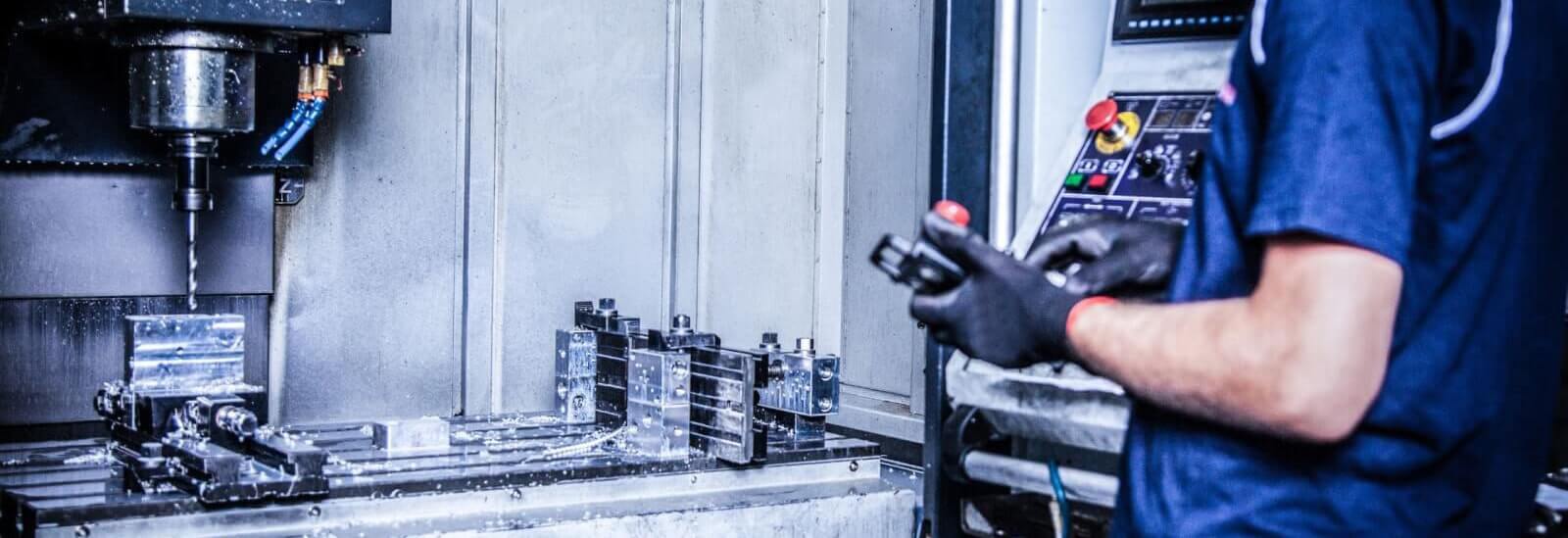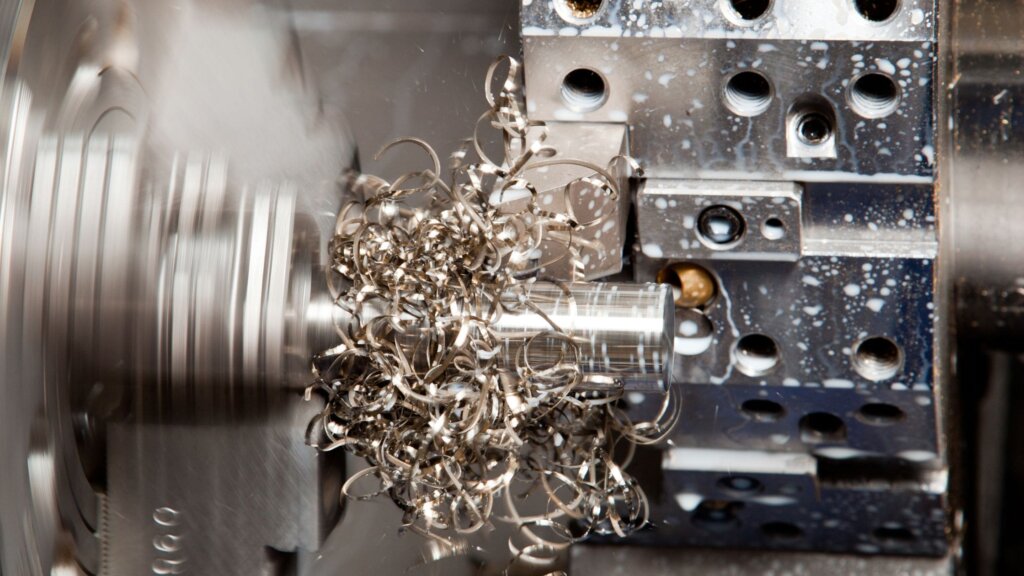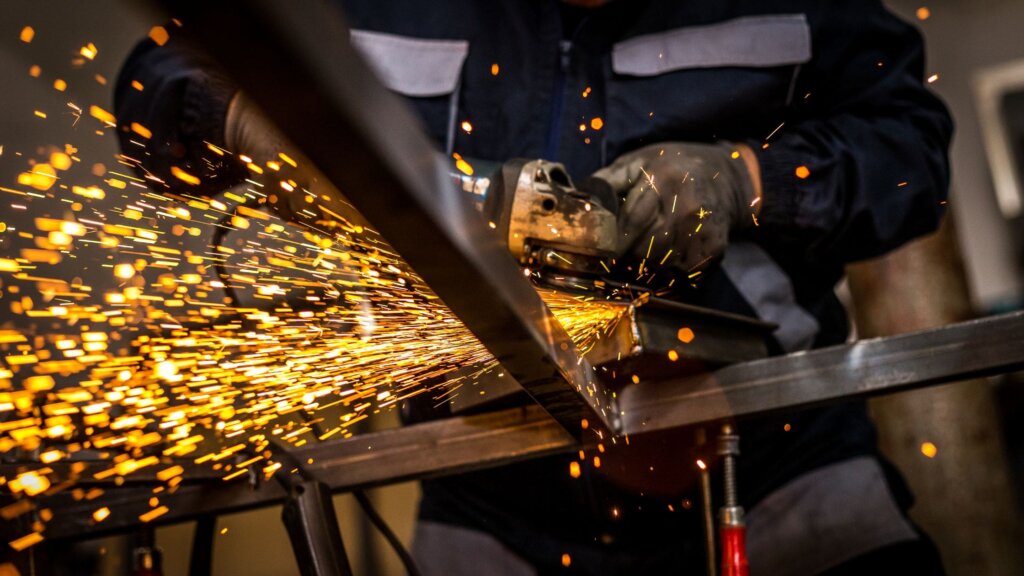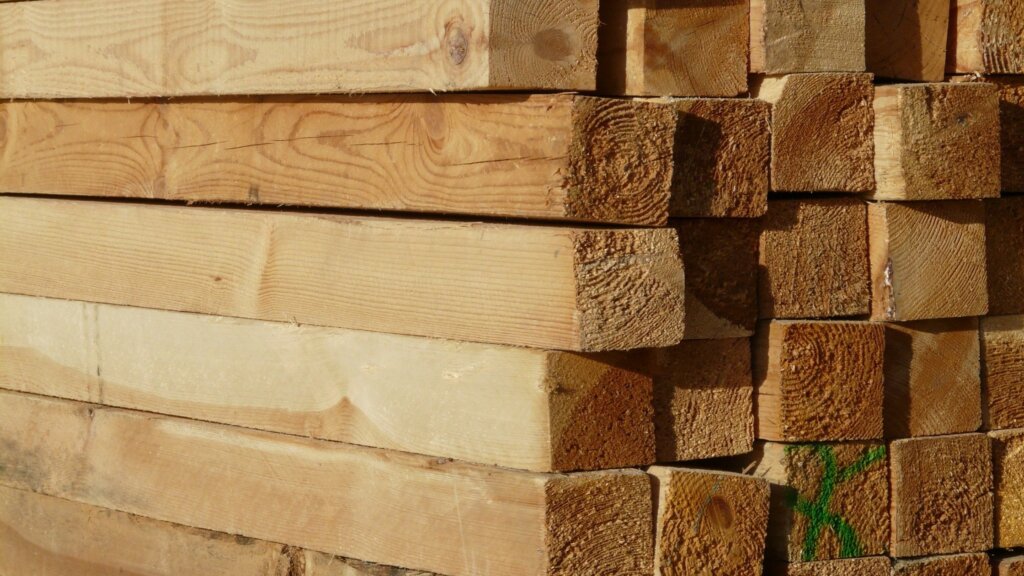
What is Machining: Definition, Types & Tools
Most of the manufactured products you see around you are created as a result of machining processes. This has been the case for centuries now, with the various steps involved in the process evolving dramatically through the ages.
Many people often ask about the basics of what is machining, how it works, the different types of machining processes, and many other details regarding these topics. This article will go through all this information and more, providing detailed insight into the machining world.
What is Machining?
Machining is a manufacturing process that involves shaping a piece of material to a final desired shape by removing material in a controlled manner. Since machining processes utilize machine tools like machining centers and work by removing material, they are often termed as subtractive manufacturing processes, unlike additive manufacturing, which involves а controlled addition of material.
Machining processes can work on a large number of materials, including metals, plastics, wood, glass, and more. The workability of machining processes on this vast range gives these processes applications in numerous industries.
History of Machining Processes
The history of machining processes dates back a few centuries. In the 18th century, machining processes pertained to repairing machines and equipment by using hard-working processes such as wood carving or metalworking using forging. To be precise, the term 'machinists' existed, but 'machining tools' didn't.
Machining tools came into existence later in the middle of the 20th century. This happened due to the emergence of machining processes such as drilling, turning, boring, milling, broaching, planing, sawing, reaming, taping, and more. These processes were done with manually operated machining tools such as simple lathes, drilling tools, cutting tools, or drill presses. Over the years, with the emergence of computers and various technologies, all the machining processes got associated with Computer Numerical Control (CNC).
How Does Machining Work?
The concept of machining is to start with a bigger piece of material than the required part, and then remove the material with a controlled cutting tool. In the modern manufacturing world, machining tools are controlled by Computer Numerical Control (CNC) technologies. It is a structured process that starts with a conceptual design of the desired shape and then proceeds with the execution of design on the machining tools.
Stages of the Machining Process
The machining process for any component goes through these steps in this very order:
Creating Blueprints
Firstly, it is important to create a conceptual idea of the part that is required. This is done through engineering drawings and blueprints of the part, with the intended dimensions mentioned on the blueprints. When specifying the dimensions, it is important to keep in mind the workability of materials and their mechanical strength. For instance, a wall should have a minimum thickness or the part can collapse in the machining stage itself.
Creating CAD Models
Once the blueprints of the part are ready, it needs to be converted into a digital 3D model. This is done by using Computer Aided Design (CAD) software. This is the job of a programmer. More complex parts require complex CAD programs.
The CAD models are converted to Computer Aided Manufacturing (CAM) programs. The CAM program is the language that the CNC machine understands. CAD programs can also tell if there are any issues with the design that will give errors in the machining process.
Machine Setup
The machine setup is carried out by the operator and involves adjusting the tooling and mounting the workpiece materials on the CNC machine. The setup can vary based on the type of machining process that will undergo. Setup also includes transferring the CAD instructions to the machine.
Program Execution
Once the machine is ready, the operator executes the program. The machine then works on shaping the program to the final part. It can be done in a number of ways, depending on the particular machine being used. After execution, the final part is ready and unmounted by the operator. Based on the requirement, it can be then sent for secondary machining processes.
Applications of Machining
Machining tools are used in every kind of industry for creating a wide array of parts. Some of the common types of equipment made and applications of machining processes are:
- Bicycle frames
- Engines
- Smartphone and laptop cases
- Scientific projects
- Aerospace parts
- Military and firearms equipment
- Medical and surgical equipment
- many other parts
What are the Different Types of Machining Processes?
There are many types of machining processes and operations, each with its own purpose and design. Here is a brief overview of these different machining processes:
Turning
In turning, the workpiece rotates around a central axis while the cutting tool shaves off material from it. This method is used for the symmetrical shaping of a workpiece. The cutting tool can be controlled by the computer. Some applications of the turning process are:
- Engine components
- Machine components
- Shafts
- Threads
- Tapers
Milling
Milling involves a rotating cutting surface moving against the workpiece to create different shapes of planes. The cutting shapes can range from simple straight cuts to angled and inclined surfaces for particular purposes. There are many different milling tools to accomplish this, such as bed mill, column mill, gantry mill, C-frame mill, knee mill, turret mill, ram-type mill, and more. Some applications of milling tools are:
- Gears
- Slotting and Grooves
- Aerospace components
- Agricultural equipment
- Automotive parts
- Energy sector
Drilling
Drilling tools are one of the simplest types of machining equipment. Their purpose is to move around the workpiece and create holes using drill presses. The holes are done for inserting screws, secondary assembling, or just for aesthetics. Applications of drilling are:
- Screw holes
- Fuel injector bodies
- Heat exchanger tubes
- Fluid assembly ends
- Aircraft landing gear
Boring
Boring tools enlarge previously drilled holes in the workpiece. This is done either with a single-point cutting tool or an assortment of such tools. In a way, boring is a counterpart to turning, the major difference being that boring works on the internal diameter while turning tools work on the external diameter. Common applications of this process can be seen in barrels of firearms or engine cylinders. Applications of boring are:
- Engine cylinders in the automotive industry
- Cranes and end loaders
- Mining
- Firearms
Reaming
Reaming is a process for slightly widening the diameter of a drilled hole and adding an internal surface finish to it. This process is used when a hole of a very precise diameter or surface finish is required, which drilling tools cannot provide. The usual process to create a precise hole using reaming is to drill an undersized hole and then use reaming for widening the hole to the precise width and finish. Applications of reaming are:
- Screw cutting
- Turret lathe
- Removing burrs
Grinding
- Brake cylinders and pistons
- Hydraulic steering pistons
- Gear shafts
- Surgical drills
- Hip stems
- Femoral knee joints
- Aerospace components
- Furniture industry
Planing
Planing is the process of generating flat surfaces on a workpiece, done with a machine called a planer. Planers utilize the relative motion between a single-point cutting tool and the workpiece to generate the cutting action. Besides linear planing, they can also be used for helical planing applications. Applications of planing include:
- Generate flat surface for any requirements
- Creating multiple slots at the same time
Sawing
Sawing is one of the earliest machining processes. It utilizes a sharp blade (sometimes replaced with a wire or a chain) with toothed edges. It is most commonly used in woodworking but also finds some applications in metalworking and stone cutting applications. Some of the uses of sawing are:
- Wood cutting
- House making
- Furniture making
- Tile cutting
Broaching
In broaching, the unwanted material removal is done through a toothed cutting tool. This tool is termed as a ‘broach’. Broaching can be done in two ways- linear and rotary, with the linear method being more common. This process is great for the precision machining of niche shapes. Some common applications of broaching are:
- Internal keyways
- Non-circular holes
- Splines
- Screw machine parts
- Stampings
Burning Machining Techniques
The burning machining process utilizes a high temperature for removing material, instead of a sharp cutting tool used by the conventional machining techniques. In essence, the removed material gets melted away when the burning tools apply heat. The process of melting depends on the type of burning techniques used. There are three common methods of burning machining techniques:
Laser Cutting:
In laser cutting, material removal occurs through a highly focussed light beam. It is used for cutting materials in any shape required. The process works on both metals and non metals. It is one of the most precise cutting methods out there. Some applications of laser cutting are:
- Foils
- Films
- Laminates
- Label Stock and PSA
- Rubber
- Gaskets
- Plastics
- Textiles
- Aggressive Adhesive Materials
Plasma Cutting:
Plasma cutting uses a stream of ionized gas for melting and removing material. The process requires the workpiece to conduct electricity, so it only works for metals and conductive alloys. Some applications of plasma cutting are:
- Fabrication workshops
- Automotive repair and customization
- Salvage and scrapping
- Industrial construction
Oxy Fuel Cutting:
Oxy fuel cutting is also known as gas cutting. This is a very old cutting method that uses a mixture of oxygen and a combustible fuel gas such as acetylene, natural gas, propane, or propylene) to remove material by melting. It is not as precise as laser or plasma cutting. However, the equipment is highly portable. Applications of this process are:
- Stone working
- Automotive industry
- Loosening seized fasteners
- Hardfacing
- Welding
Erosion Machining Techniques
Erosion machining techniques remove material by turning it into particles that are removed by the machining techniques. As in the case of burning machining techniques, there are multiple ways to accomplish erosion machining:
Water Jet Cutting
Water jet cutting is a very popular method that uses the sheer force of high pressure water to create the cutting action. It works on every type of materials such as metals, wood, stone, ceramics, plastics, paper, rubber, and more. The shapes can be complex and intricate, depending on the number of axes in the machine. Some of the applications of this process are:
- Paper industry
- Mining
- Art installations
- Insulators
- Surgical equipment
- Food industry
EDM Cutting
EDM stands for Electric Discharge Machining, with other names such as spark erosion, spark machining, wire burning, wire erosion, or die sinking. This process is used in the metal fabrication industry as it only works for electrically conductive materials. In this method, material removal occurs through rapid sparks (discharges due to electrical arc), generated by a high voltage. Applications of this method are:
- Prototyping
- Dies for coin production
- Metal disintegration machining
- Closed loop manufacturing
CNC Machining
CNC machining is not a machining method in itself, but a technology that is applied to other methods. It stands for Computer Numerical Control and allows for the automated control of a machine. It requires a high initial cost and a skilled operator but saves labor costs and time. It is utilized in all modern industries due to the high production rate required.
Precision Machining
Precision machining is an evolved usage of CNC machining where the parts are created with a high degree of accuracy. It utilizes the various machining methods mentioned above, with the highest standards of quality in the cutting tool, tooling, and other areas. It is usually required in areas where consistency is required on a micro or nano scale, such as electronics, aerospace, military, medical, or other such industries.
What are the Different Machining Tools?
The machining tools used in a process depend on the machining method being utilized. Some of the common machining tools are:
Turning tools
There are many different types of turning tools, such as:
- Bowl gouge
- Spindle gouge
- Roughing gouge
- Oval skew chisel
- Round nose scraper
- Parting tool
- Hollowing tool
Milling tools:
The various tools involved in the milling operations are:
- Face mill
- End mill
- Ball cutter tool
- Slab mill
- Side and face cutter
- Fly cutter
- Hollow mill
- Shell mill
- Dovetail cutter
- roughing end mill
- Woodruff cutter
Grinding tools:
There are many different types of grinding tools, such as:
- Belt grinder
- Bench grinder
- Surface grinder
- Tool and cutter grinder
- Jig grinder
- Gear grinder
- Center grinder
- Die grinder
- Angle grinder
Drilling tools:
There are many different types of drilling tools, such as:
- Hand drill
- Hand drill with brace
- Standard electric drill
- Hammer drill
- Benchtop drill
In every drill, there is the option to use varying end bits depending on the requirement. Some common bits options are:
- Twist bits
- Masonry bits
- Dowel bits
- Flat bits
- Augers
Boring tools:
While boring is a simple task, it can use a number of tools for customization. Some common boring tools are:
- Rough boring heads
- Fine boring heads
- Twin cutter boring heads
- Digital boring heads
- Specialty boring heads
- Modular boring tools
What are the Advantages of Machining?
Machining techniques have been in use for so long because of the countless benefits they have to offer against any other manufacturing process, such as additive manufacturing. Some of the benefits of machining techniques are:
- Versatile Process: Machining is a highly versatile process when it comes to the number of materials it can work on. While additive manufacturing methods generally work on only plastics, machining is not limited to any such case. It can work on metals and nonmetals alike, as we will see in the later section about the material application of machining operations.
- Precision: CNC machining provides a precision that cannot be matched by any other method. It is easy to achieve machining tolerances of around 0.001″. Even lower tolerances are possible by using specialty tools of precision machining.
- Surface Finishing: Machining operations provide multiple options when it comes to surface finishing. Additionally, the machining process is quite smooth which can eliminate the requirement for any later secondary finishing stages, saving time and costs.
- High-Density Machining: Many situations, especially in the aerospace and defense industry, require parts made out of the toughest materials out there. These materials are hard to shape with other manufacturing methods. However, machining can work on these high-density materials with ease.
- Labor Saving: The machining manufacturing process in this day and age is automated and controlled by computers. There is no requirement for manual handling of the tools. This saves labor to a large extent and human resources can be replaced to high priority intellectual applications.
- Production Rate: Machining can provide a high production rate, suitable for mass production. The rate can be adjusted and lower quantities can be extracted out of the machining operations for use cases such as prototyping or tooling.
- Consistency: Machining operations have high repeatability and consistency. This is because of the fact that the tools are controlled by a computer, so the movement and working of tools will be the same without any human error involved. This is very beneficial for mass production where customers look for consistent products.
- Higher Profits: Due to the exponentially faster production and lower labor costs, manufacturers can take out higher profits from the manufacturing process. Machining operations also have lesser infrastructure requirements, leading to lower expenses.
What are the Disadvantages of Machining?
While machining is the core pillar of modern manufacturing, there can be some disadvantages to the process such as:
- Limitation to Machinable Surface: There is a limitation to the number of surfaces that can be machined in a workpiece. The area under the clamps and the side touching the worktable often aren’t reachable by the rotating cutting tool. To machine these surfaces, the operator needs to unmount the workpiece, change its orientation, and mount it again.
- Operator Skill: While the human labor in machining is highly reduced, there is a higher emphasis on operator skill. An unskilled operator can lead to low-quality production, damage to the workpiece, or even damage to the machine. Additionally, the machining of complex products also requires a skilled programming team.
- Initial Cost: The initial cost of industrial machining setups can be very high. Multi-axis milling machines are great for the rapid production of complex parts, but the high cost of these machines discourages manufacturers from buying these machines.
These disadvantages to machining can be easily avoided by outsourcing the machining requirements to a third-party manufacturer. 3ERP is the best solution in this regard, with the most advanced equipment and a highly experienced team.
What Materials Can Be Machined?
There is no limit when it comes to the materials that can undergo machining processes. Some of the popular options are:
Aluminum
The low weight and high strength of aluminum make it an attractive material for many manufacturers. This is why it is one of the most common types of machining materials. Machining works on all grades of aluminum such as Aluminum 6061, 7075, 6082, 5083, etc.
Steel
Steel, an alloy of iron and carbon, is a very versatile and rugged material. There are many different varieties of steel obtained after altering the amount of carbon in the composition. All these variations of steel are machinable. Some common examples are stainless steel, carbon steel, mild steel, etc.
Brass
While brass is an expensive material, it also undergoes machining very often. Some common applications of brass machining are in art pieces and sculpting.
Titanium
Titanium is one of the hardest metals out there. Machining of titanium parts is done when the requirements call for the high strength and density characteristics of titanium.
Wood
Plastics
Plastics comprise a wide class in themselves. All varieties of plastics, including thermoplastics and thermosetting plastics, can undergo machining. Machining of plastics provides a higher precision than other methods such as injection molding or 3D printing.
Machining Terminology
Due to the technical nature of machining, people in the industry need to be aware of the terminology used in machine shops. There are many different types of machining, so the complete list of terms is quite vast. Here are some commonly used terms:
- Adapter: Adapts a tool of a particular size into a machine of different size requirement
- Allowance: Used to denote the difference in the measurements of two mating parts
- Apron: The part of a machine (usually lathe) that contains and protects the gears, clutches, and other components
- Axis: The imaginary line that passes through the center of an object around which it can rotate. Used to denote the capability of a CNC machine (such as a 5-axis milling machine).
- Bearings: Used between moving parts to highly reduce friction
- Tool/Bit: Part made of titanium or hardened steel used for generating the cutting action
- Burr: Sharp edges and corners on the final part after machining
- Chamfer: Curved surface cut on the edges or corners of a workpiece
- Coolant: Liquid filled in a CNC machine to reduce heat buildup and increase workability
- Headstock: Fixed end of a CNC machine
- Setup: Tasks done before starting the machining, such as adjusting settings and mounting the workpiece.
- Stock: Materials used to make the final part
What is the Average Cost of Machining?
The price bracket of machining is a very wide field. The cost of the machine itself can start at a few thousand dollars and go over $500,000. The hourly costs depend on whether you are using a multi-axis machine or not. For instance, 3-axis machines can cost an hourly rate of $40, while this cost can go up to $120 per hour for multi-axis machines.
Skill Requirement for High-Quality Machining
A high-quality machining project can call for skills such as:
- Mechanical engineering
- CAD/CAM programming knowledge
- Machine operation skill
- Manual labor for mounting/unmounting
- Mathematics and Geometry
- Reading blueprints
- Problem solving
Frequently Asked Questions
Here are the answers to some commonly asked questions regarding machining:
Is machining difficult?
The difficulty level of machining depends on the complexity of the manufactured part and the skill of the team. A highly skilled team can machine a complex part with ease, while an unskilled team might find it hard to machine even simple parts.
What is the most common machining process?
Drilling and grinding are some of the most common machining processes, used in almost every industry and with every other machining process.
What is the difference between machining and manufacturing?
Manufacturing is a vast area that covers additive processes and subtractive processes. However, machining only includes subtractive manufacturing processes.
Start Your CNC Project Today
3ERP is a precision CNC machining and CNC prototyping company with capabilities including milling, turning, wire EDM, aluminum machining, and more. Our skilled machining experts combined with our 3-, 4-, and 5-axis CNC machining capabilities allow us to achieve exceptional levels of precision, quality, and complexity for even the most complex or critical applications. With years of experience in our field, we have the expertise to provide comprehensive precision machining services that meet the standards of myriad industries.
To learn more about how our rapid prototyping and CNC machining services can benefit your next project, please contact us or request a quote today.




